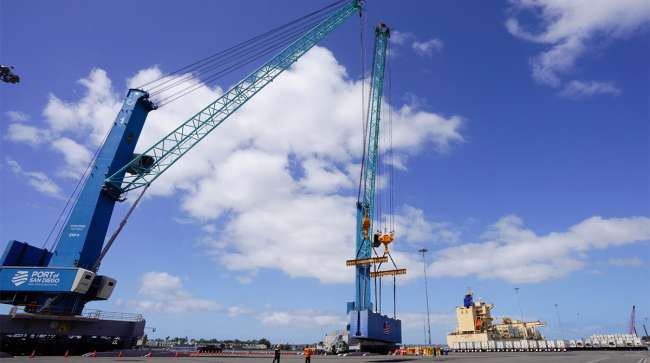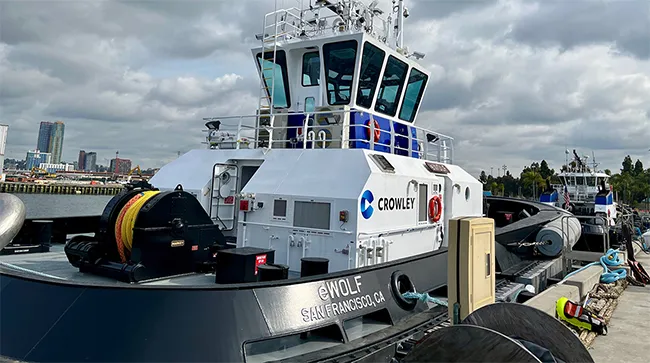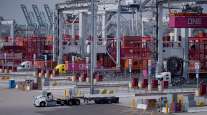All-Electric Cranes Lift Cargo at Port of San Diego

[Stay on top of transportation news: Get TTNews in your inbox.]
With the recent deployment of two massive, all-electric harbor cranes, the Port of San Diego is about two-thirds of the way from reaching its ambitious zero-emission targets.
“This is a big, big deal,” port chairman Frank Urtasan said Sept. 17 as crane operators put on a demonstration for state, city and elected officials at the port’s Tenth Avenue Marine Terminal.
Soaring 262 feet high and weighing 685 metric tons each, the pair replace one older crane that ran on diesel fuel. The move will slash greenhouse gas emissions by 47 metric tons per year.
In use since March, the cranes significantly increase the capacity for on-loading and off-loading cargoes at the Tenth Avenue Marine Terminal from 100 metric tons to as much as 400 metric tons.
We’re excited to introduce North America's first all-electric mobile harbor cranes, now in operation! 🚢 These cranes replace diesel equipment and are transforming the way we move oversized shipments, like wind turbines, industrial machinery, and more. https://t.co/5O3RxFBxcH pic.twitter.com/4t5jhZONJg — Port of San Diego (@portofsandiego) September 18, 2024
“What that means for San Diego is we have the highest lift capacity, essentially, from our border with Canada to all the way down to the Panama Canal,” said Greg Borossay, principal of maritime business development at the port.
The cranes, which can move from berth to berth, are the first all-electric mobile cranes installed at any port in North America.
The port ordered them from Konecranes, a Finnish company that built the cranes in Düsseldorf, Germany, for about $14 million. The port will spend an additional $8.9 million on electrical infrastructure improvements.
That’s a total price tag of about $23 million, a big chunk of the port’s budget of roughly $200 million. But a combination of local, state and federal dollars helped defray costs.

Urtasun
The port received a $2.7 million grant from San Diego County Air Pollution Control District, about $14 million in American Rescue Plan Act funds that are administered by the California State Lands Commission and $3.6 million from California’s Low Carbon Fuel Standard in which proceeds are accrued through the state’s cap and trade program.
Port officials expect the project will have a payback period of 11 to 13 years.
“When you operate the cranes, you use the existing power grids here,” said Robert Vennemann, marketing manager for Kronecranes. “So you’re just buying electricity, which in most countries in the world is cheaper than diesel (fuel).”
The electric cranes are expected to reduce diesel particulate matter emissions from cargo handling equipment by 15 % at the Tenth Avenue terminal. The cranes are one part of a $125 million effort spent thus far to meet the port’s Maritime Clean Air Strategy to transition all cargo handling equipment to zero-emissions by 2030.
“Yes, it’s expensive, $125 million is a lot of money,” Urtasan said. “But we’re doing it in a way that is getting great results.”

The 82-foot, all-electric eWolf tugboat sits dockside at the Tenth Avenue Marine Terminal at the Port of San Diego in California. (Rob Nikolewski/The San Diego Union-Tribune/TNS)
Earlier this year, the Port of San Diego became the first in the U.S. to launch an electric tugboat — the 82-foot eWolf, operated Crowley Maritime Corp. Capable of speeds of up to 12 knots, the tug has bollard pull (that is, thrust) of 76.8 short tons, which is more powerful than the port’s diesel-powered counterparts.
Urtasan said the port is 66% done with its zero-emission targets. Cleaning up emissions from trucking heading in, moving around and exiting the port will represent the final phase.
The efforts will help clean the air at nearby South Bay communities such as Barrio Logan, Logan Heights and National City.
“It also has benefits for port workers,” said Liane Randolph, chair of the California Air Resources Board. “Workers here at the port are already exposed to the same diesel pollution, but at closer proximity. So transitioning this equipment to zero-emission also protects the workers here at the port.”
The electric cranes and other infrastructure are hooked up to a microgrid the port recently unveiled.
The target cargo for the two cranes will be renewable energy projects, such as batteries and large pieces of equipment that go into assembling wind farms built around the West.
Want more news? Listen to today's daily briefing above or go here for more info
“We’re going to be able to tap into some of the cargo that heretofore has been going all the way from Asia through the Panama Canal into Texas,” said Borossay. “We’re going to be able to pull some of that cargo back to California from Texas for these projects. It puts us back in the game because we have this heavy-lift capacity.”
A self-sustaining entity, the Port of San Diego budget does not collect tax dollars. Its revenue comes from a variety of sources including commercial real estate around San Diego Bay, fees from ships using the port’s docks, wharves and cargo terminals that bring in everything from cars to wind turbines to sugar and bulk items.
Established in 1962, the San Diego Unified Port District includes 34 miles of waterfront property stretching from Shelter Island to the border. Port officials manage everything from cargo and cruise terminals to hotels, restaurants, marinas, museums and 22 public parks and events along the coastline.
Distributed by Tribune Content Agency, LLC




